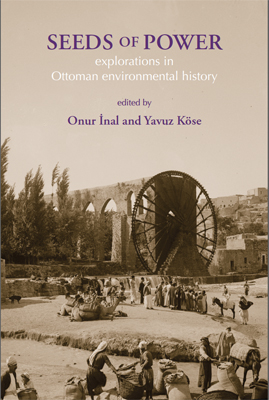Seeds of Power
Explorations in Ottoman Environmental History

Edited by Onur İnal and Yavuz Köse
NATURE, POWER AND THE OTTOMAN EMPIRE
The Ottoman Empire was one of the greatest early modern world empires, stretching from the outskirts of Vienna in the west to the Caucasus Mountains in the east and from the tip of Arabian Peninsula in the south to the Ukrainian steppes in the north, covering an area of 3.81 million square kilometres. The Ottomans were remarkable not just for their political and military success but also for their desire and ability to understand, adapt, modify and manage different environments. This edited volume is the first collective effort to take an original look at the Ottomans through the lens of environmental history. In its wide-ranging essays, environmental perspectives illuminate diverse historical processes and events in the long history of the Ottoman Empire. The essays thus offer new answers to old questions – but also ask new questions – about the ways the Ottomans related to, depended on, thought about and interacted with the natural environment. It will appeal to anyone interested in the environmental history of one of the world’s largest and most durable empires, the longest-lasting in the history of the Muslim world.
LOOK INSIDE THIS BOOK at Amazon.co.uk
THE EDITORS
Onur İnal is a post-doctoral researcher at the University of Vienna and founder of Network for the Environmental History of Turkey (NEHT). His research focuses on the urban and environmental histories of the late Ottoman Empire and early Republican Turkey.
Yavuz Köse is Professor of Turcology at the University of Vienna, board member of TürkeiEuropaZentrum (TEZ), and president of the Society of Turkic, Ottoman and Turkish Studies (GTOT). He researches the social, economic, and consumption history of the Ottoman Empire and Turkey. Particularly, he is interested in the effects of modernisation and globalisation in the late Ottoman Empire.
‘an essential contribution to the environmental history of the Ottoman Empire.’
Faith Ermis – H/Soz/Cult
‘The chapters that comprise Seeds of Power reflect the richness of social, agricultural, and economic history in the literature that describes the Ottoman Empire’
Jennifer Derr – Turkish Historical Review
‘In Seeds of Power, Onur İnal and Yavuz Köse capture how Ottoman environmental history has bloomed in the past decade and offer by far the best guide yet to the methods and issues that dominate the nascent field.’
Faisal Husain – Environmental History
‘Seeds of Power perfectly demonstrates that the available sources can be used to tell a different story, reconceive the ways we write Ottoman history, comprehend social, political, and cultural transformations from a new window, and reconceptualize the notions of empire, geography, space, capitalism, and class in Ottoman history.’
Önder Eren Akgül – YILLIK: Annual of Istanbul Studies
‘… will for years play the role of a yardstick for the subsequent publications in the field.’
Stefan Peychev – Der Islam
‘… İnal and Köse’s edited volume ought to be seen as one of the first significant steps towards the recognition of environmental history in the Middle East and Southeastern Europe.’
George Vlachos – The Historical Review / La Revue Historique
CONTENTS
Foreword. Ottoman and Nature. ALAN MIKHAIL
Introduction. The Ottoman Environments Revisited. ONUR İNAL and YAVUZ KÖSE
- Chapter 1. Searching for the ‘Little Ice Age’ Effects in the Ottoman Greek Lands: The Cases of Salonica and Crete. ELIAS KOLOVOS and PHOKION KOTZAGEORGIS
- Chapter 2. A ‘Magnificent’ Climate: Demography, Land and Labour in Sixteenth-Century Anatolia. MEHMET KURU
- Chapter 3. Producing Grapes and Wine on the Bosporus in the Eighteenth Century: The Testimony of Domenico Sestini. SURAIYA FAROQHI
- Chapter 4. Fruits of Empire: Figs, Raisins, and Transformation of Western Anatolia in theLate Nineteenth Century. ONUR İNAL
- Chapter 5. ‘It’s a Bad Fate to be Born Near a Forest’: Forest, People and Buffaloes in the Mid-Nineteenth Century North-western Anatolia. SEMİH ÇELİK
- Chapter 6. Water Management Issues in an Ottoman Province: The Case of Cyprus in the Seventeenth Century. STYLIANI LEPIDA
- Chapter 7. Nature’s ‘Cosmopolitanism’: Villagers, Engineers and Animals along Terkos Waterworks in Late Nineteenth-Century Istanbul. K. MEHMET KENTEL
- Chapter 8. Cesspools, Mosquitos and Fever: An Environmental History of Malaria Prevention in Ismailia and Port Said, 1869–1910. MOHAMED GAMAL-ELDIN
- Chapter 9. The Rice Debates: Political Ecology in the Ottoman Parliament. CHRIS GRATIEN
- Chapter 10. Discovering the Nature of the New Homeland: Alexander von Humboldt (1769–1859) in the Ottoman Empire and in Early Republican Turkey. YAVUZ KÖSE
- Chapter 11. Dispossession by Concession: Forest Commons in the Ottoman Empire and Early Turkish Republic. SELÇUK DURSUN
Publication date, 31 March 2019
ISBN 9781-874267-997 (HB) £65. 250 pp.
ISBN 9781-912186-815 (PB) £30. 250 pp.
